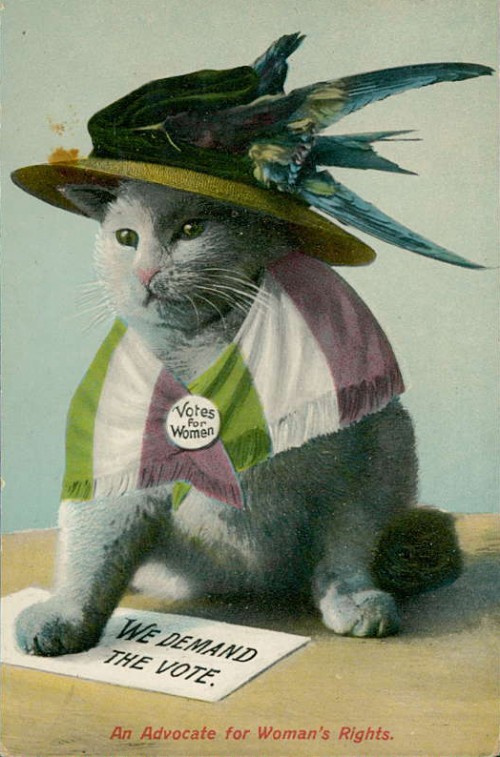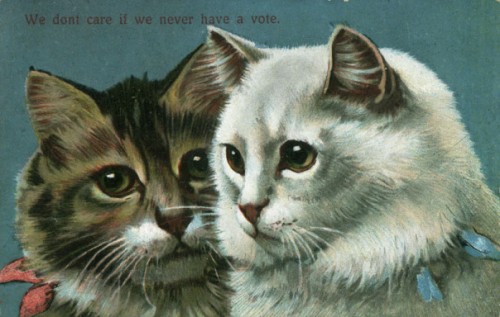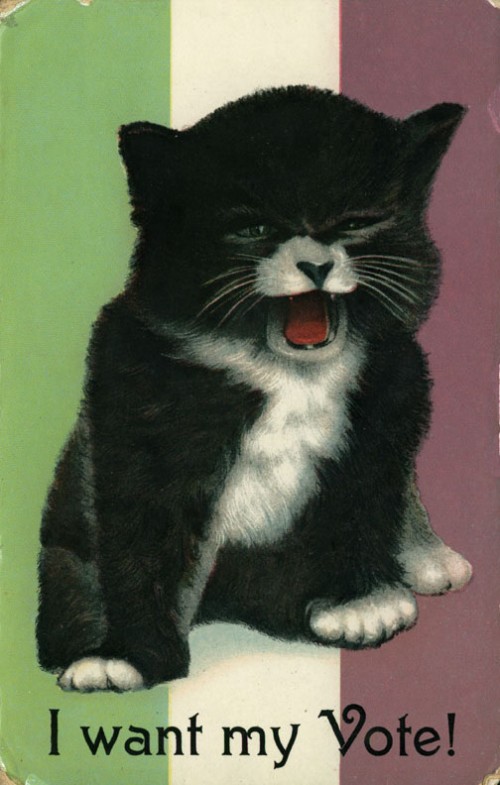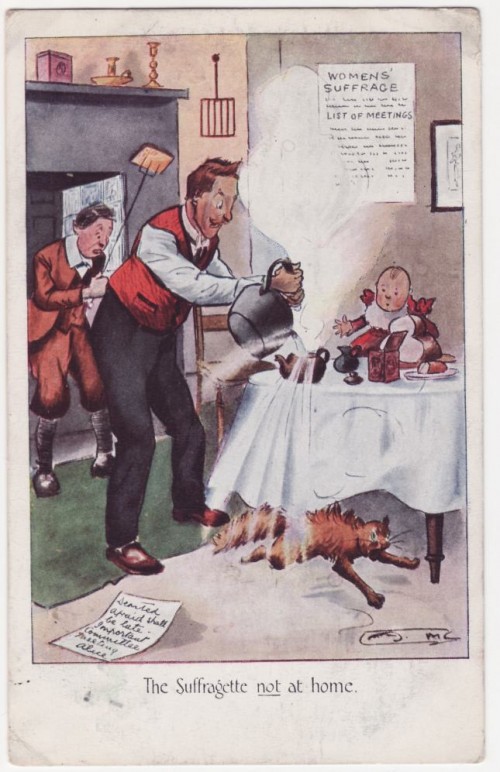Cats and dogs are gendered in contemporary American culture, such that dogs are thought to be the proper pet for men and cats for women (especially lesbians). This, it turns out, is an old stereotype. In fact, cats were a common symbol in suffragette imagery. Cats represented the domestic sphere, and anti-suffrage postcards often used them to reference female activists. The intent was to portray suffragettes as silly, infantile, incompetent, and ill-suited to political engagement.
Cats were also used in anti-suffrage cartoons and postcards that featured the bumbling, emasculated father cruelly left behind to cover his wife’s shirked duties as she so ungracefully abandons the home for the political sphere. Oftentimes, unhappy cats were portrayed in these scenes as symbols of a threatened traditional home in need of woman’s care and attention.
While opposition to the female vote was strong, public sentiment warmed to the suffragettes as police brutality began to push women into a more favorable, if victimized, light.
As suffragettes increasingly found themselves jailed, many resisted unfair or inhumane imprisonment with hunger strikes. In response, jailers would often force-feed female prisoners with steel devices to pry open their mouths and long hoses inserted into their noses and down their throats. This caused severe damage to the women’s faces, mouths, lungs, and stomachs, sometimes causing illness and death.
Not wanting to create a group of martyrs for the suffragist cause, the British government responded by enacting the Prisoner’s Act of 1913 which temporarily freed prisoners to recuperate (or die) at home and then rearrested them when they were well. The intention was to free the government from responsibility of injury and death from force feeding prisoners.
This act became popularly known as the “Cat and Mouse Act,” as the government was seen as toying with their female prey as a cat would a mouse. Suddenly, the cat takes on a decidedly more masculine, “tom cat” persona. The cat now represented the violent realities of women’s struggle for political rights in the male public sphere.
The longevity of the stereotype of cats as feminine and domestic, along with the interesting way that the social constructions flipped, is a great example of how cultural associations are used to create meaning and facilitate or resist social change.
Cross-posted at Jezebel and Human-Animal Studies Images.
Ms. Wrenn is an instructor of Sociology with Colorado State University, where she is working on her PhD. She is a council member of the American Sociological Association’s Animals & Society section and has published extensively on the non-human animal rights movement.








Comments 28
Kalii — December 5, 2013
Wow...This is awesome. Did not know that cats were used during those times. I am going to share this with my fellow feminist classmates. Thank you for the historical lesson!
TMK — December 6, 2013
Well, personally i fully support the suffrage of cats. Cuuuute ;)
Kali — December 6, 2013
"public sentiment warmed to the suffragettes as police brutality began to push women into a more favorable, if victimized, light."
That poster with the hurt and bandaged cat doesn't look very sympathetic to me. It looks like they are making fun of the pain and suffering of the women who were imprisoned and tortured.
The Strange Historical Origin of the Crazy Cat Lady « HowAboutWe – Date Report — December 13, 2013
[…] face of single ladies and lesbians, cats were the face of the anti-suffrage movement, according to a fascinating article in Sociological Images tracing the political history of British felines. In the early 1900s, […]
Weekend Reading | Backslash Scott Thoughts — December 15, 2013
[…] Woman-as-Cat in Anti-Suffrage Propaganda. […]
teknohed — December 18, 2013
wait, cats are thought to be especially good pets for lesbians? I was not aware of that societal norm.
The “Crazy” Cat Lady | jessicakumanovski — March 25, 2014
[…] theory on the lunacy of cat lovers, put forth by the blog Sociological Images, suggests that the British […]
Crazy Cat Lady: An [Incomplete] History | Just for Grins — July 31, 2014
[…] The actual article explains it much better, plus it has some great pictures of anti-voting cats. Who doesn’t love that? Check it out here. […]
Crazy Cat Lady: An [Incomplete] History « Positively Grinworthy — August 15, 2014
[…] The actual article explains it much better, plus it has some great pictures of anti-voting cats. Who doesn’t love that? Check it out here. […]
Stop Trying to Debunk the ‘Cat Lady’ Myth — June 11, 2015
[…] cat and woman thoroughly domesticated. So much so that when women took up the suffrage movement, anti-suffrage postcards used cats to depict “suffragettes as silly, infantile, incompetent and ill-suited to political […]
The Crazy Cat Lady | The Bemusing — August 12, 2015
[…] to the site TheSocietyPages.com, cats were often used in anti-suffrage propaganda. Initially, they were used as a symbol of femininity, as opposed to the masculine dog. In the […]
The Bizarre History Of Anti-Suffrage Cat Memes | business via blog — November 3, 2016
[…] piece, I accidentally mistook a few suffrage pamphlets and postcards as pro-suffrage because, well, they had cats on them, and cats are a woman’s best friend…. right? I quickly realized that the adorable cats […]
The Bizarre History Of Anti-Suffrage Cat Memes | Unpopular Opinion — November 3, 2016
[…] piece, I accidentally mistook a few suffrage pamphlets and postcards as pro-suffrage because, well, they had cats on them, and cats are a woman’s best friend…. right? I quickly realized that the adorable cats […]
The Bizarre History Of Anti-Suffrage Cat Memes | News Outlet — November 5, 2016
[…] piece, I accidentally mistook a few suffrage pamphlets and postcards as pro-suffrage because, well, they had cats on them, and cats are a woman’s best friend…. right? I quickly realized that the adorable cats […]
Hail the rise of cat men, an antidote to toxic masculinity - Australia news,World News, Politics, Economics, Entertainment,Sport,Business & Finance | Australia news,World News, Politics, Economics, Entertainment,Sport,Business & Finance — December 10, 2016
[…] a early 20th century, illustrations of cats dressed as women were used in American anti-suffrage propaganda to etch suffragettes as stupid and unqualified of orchestrating a domestic campaign, and pollute […]
Hail the rise of cat men, an antidote to toxic masculinity | Serendib news — December 11, 2016
[…] the early 20th century, illustrations of cats dressed as women were used in American anti-suffrage propaganda to depict suffragettes as silly and incapable of orchestrating a political campaign, and debase […]
Why Are Conservative Males So Frightened of Cat Girls? - Dog Grooming News for dogs groomers and pet owners — May 4, 2022
[…] portray suffragettes as silly, infantile, incompetent, and ill-suited to political engagement,” according to the Society Pages. The concept is that if a cat is allowed to vote, one thing has gone terribly […]
Why Are Conservative Males So Frightened of Cat Women? - Pet News 2 Day — May 4, 2022
[…] portray suffragettes as silly, infantile, incompetent, and ill-suited to political engagement,” according to the Society Pages. The concept is that if a cat is allowed to vote, one thing has gone terribly […]
Why are conservative men so afraid of feline ladies? - health department — May 4, 2022
[…] portray suffragettes as foolish, childish, incompetent and unsuited to political engagement”. according to company pages. The idea is that if a cat is allowed to vote, something has gone horribly wrong. It […]
Why Are Conservative Men So Scared of Cat Ladies? - Pets in Hearts — May 4, 2022
[…] portray suffragettes as silly, infantile, incompetent, and ill-suited to political engagement,” according to the Society Pages. The idea is that if a cat is allowed to vote, something has gone terribly wrong. […]
Why Are Conservative Men So Scared of Cat Ladies? - Top Affaires - Business et formations en ligne — May 4, 2022
[…] portray suffragettes as silly, infantile, incompetent, and ill-suited to political engagement,” according to the Society Pages. The idea is that if a cat is allowed to vote, something has gone terribly wrong. […]
Why Are Conservative Men So Scared of Cat Ladies? – lieverthuis — May 4, 2022
[…] portray suffragettes as silly, infantile, incompetent, and ill-suited to political engagement,” according to the Society Pages. The idea is that if a cat is allowed to vote, something has gone terribly wrong. […]
Why Are Conservative Men So Scared of Cat Ladies? – Dog Responsibility — May 5, 2022
[…] suffragettes as foolish, infantile, incompetent, and sick-suited to political engagement,” in accordance to the Culture Pages. The strategy is that if a cat is authorized to vote, one thing has absent […]
Why Are Conservative Males So Fearful of Cat Women? - Pet News Daily — May 5, 2022
[…] portray suffragettes as silly, infantile, incompetent, and ill-suited to political engagement,” according to the Society Pages. The thought is that if a cat is allowed to vote, one thing has gone terribly […]
Why Are Conservative Men So Scared of Cat Ladies? - bromilows florist — May 5, 2022
[…] suffragettes as foolish, infantile, incompetent, and unwell-suited to political engagement,” according to the Culture Webpages. The concept is that if a cat is allowed to vote, anything has absent terribly […]
Why Are Conservative Men So Scared of Cat Ladies? - Runic Pets — May 9, 2022
[…] portray suffragettes as silly, childish, incompetent, and sick-suited to political engagement,” in accordance to the Culture Web pages. The notion is that if a cat is authorized to vote, a thing has absent […]